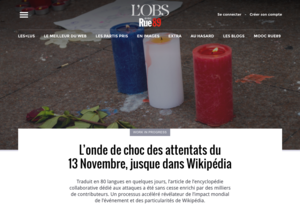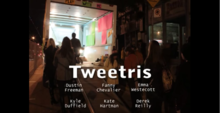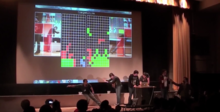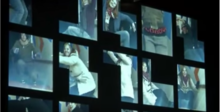Science outreach
TAN - Animated transitions demonstrator
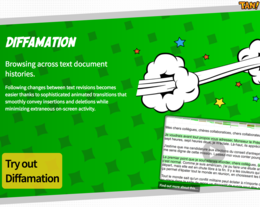
TAN (transitions animées, i.e. animated transitions) is a demonstrator set up on the Plateau Inria, EuraTechnologies, and live website (http://www.tan.lille.inria.fr) that illustrates examples of my research work in the field of animated transitions.
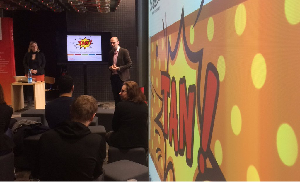
Internet, and user interfaces are overflowing with animated transitions that are sometimes annoying for users due to an excess of visual stimulation, and often pointless since the animation does not convey the right information. On the other hand, when they are well-designed, animated transitions are incredibly effective.
The TAN demonstrator proposes to illustrate examples of my ongoing research work in the field of animated transitions: Histomages, an image editing tool that associates pixel and color space; Diffamation, an animation tool to follow and understand the modifications made to a document over time; and Gliimpse, a markup language editor (e.g. HTML, LaTeX, Wiki) to instantly switch from source code to the document it produces and vice versa.
• Read the Inria bulletin about TAN • Try the demos at http://www.tan.inria.lille.fr
Publications
F. Chevalier, P. Dragicevic and C. Hurter Histomages: Fully Synchronized Views for Image Editing. CHI'12
F. Chevalier, P. Dragicevic, A. Bezerianos and J.D. Fekete (2010) Using Text Animated Transitions to Support Navigation in Document Histories. CHI'10.
P. Dragicevic, S. Huot and F. Chevalier (2011) Gliimpse: Animating from Markup Code to Rendered Documents and Vice-Versa. UIST'11.
Data journalism: revisiting Wikipedia edits during Paris Attacks
The mondial impact of Paris attacks, on Friday November 13, 2015 has been immediately reflected in the collaboarative encyclopedia Wikipedia. Together with Thierry Noisette, journalist at L'Obs - Rue89, we have written a press article that analyzes and retraces the edits in the French Wikipedia article.
The article incorporates video segments animating the evolution of the article during the 24hour following the attacks. We used our research prototype Diffamation to create the animations based on Wikipedia history.
Tweetris - Play tetris with your body
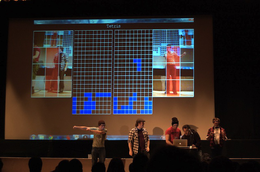
Broadly interested in playfully blurring the boundaries between digital and physical, together with researchers, computer scientists and independant artists, we have designed Tweetris. Described as a combination of Tetris, yoga and Twitter, Tweetris is a Kinect-based two player game based on whole-body interaction that has attracted thousands of players during our exhibits.
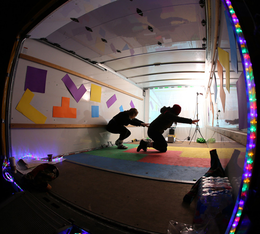
The core part of Tweetris is the shape-matching game, where two players race to match the shape of their body to a tetromino, i.e. a shape composed out of four squares taken from the game Tetris. This gameplay idea was inspired by the Japanese television show Brain Wall. Whoever makes the correct shape fastest has their picture taken and uploaded to an account on Twitter, and anyone can go to a website and play a custom game of Tetris, where the pieces are overlaid with images of winners from the shapematching game.
This artistic project is the result of a common effort of researchers at Digital Futures Initiative (OCAD University), computer scientists at the University of Toronto and Dalhousie University, and independent artists.
Tweetris has been exhibited at different venues, including Toronto Nuit Blanche 2011, Gamercamp (Toronto, 25-17 November 2011), Dalhousie University open house 2011 (14 October 2011), TEI'12: Sixth International Conference on tangible, embedded and embodied interaction - Art Exhibits (19-22 February 2012), Nocturne: Art at Night festival in Halifax and Antigonight Art After Dark Festival 2013.
The project was awarded "Emma Candy Award" at the Creativity \& Cognition 2013 conference, and "Best artist" (among 84 installations) at the Nocturne: Art at Night festival in Halifax.
• Read the Dalhousie University bulletin about Tweetris
• People performing tetrominos on Twitpic (TweetrisHal, TweetrisTEI, TweetrisTO)
Watch the videos!
Publications
D. Freeman, F. Chevalier, N. Lapierre and D. Reilly. A Study of Whole-Body Interaction During a Public Art Event. C&C '13.
D. Reilly et al. (2013) Mammoth Stickman plays Tetris: whole body interaction with large displays at an outdoor public art event. CHI'13 (Workshop paper)
D. Reilly, F. Chevalier and D. Freeman (2013) Blending Art Events and HCI Research. Interactive Experience in the Digital Age. Springer.
D. Reilly, F. Chevalier and D. Freeman (2013) Ethics and Pragmatics of Blending Art Events and HCI Research: Tweetris Experiences. C&C Workshop.
Press interviews
• C'est quoi un algorithme?, NordÊka, December 2016.
• Ask-me-anything J'étudie les relations Homme-machine. Vous m'avez posé vos questions L'Obs - Rue89, octobre 2015.
• New graph navigation techniques, France Info (Info Sciences) interview, December 2009.
Workshop Organising
• Systems, Synergies and Data Landscapes, 5-day long workshop at the Universidade de Brasília, Brasília, November 2012. Co-leader, with Sara Diamond (OCADU), Derek Reilly (Dalhousie University) and Linda Montgomery (OCADU)• Introduction to Information Visualization, Centre for Innovation in Information Visualization and Data Driven Design, Toronto, ON, April 2010. Co-leader with Sara Diamond (OCADU)
